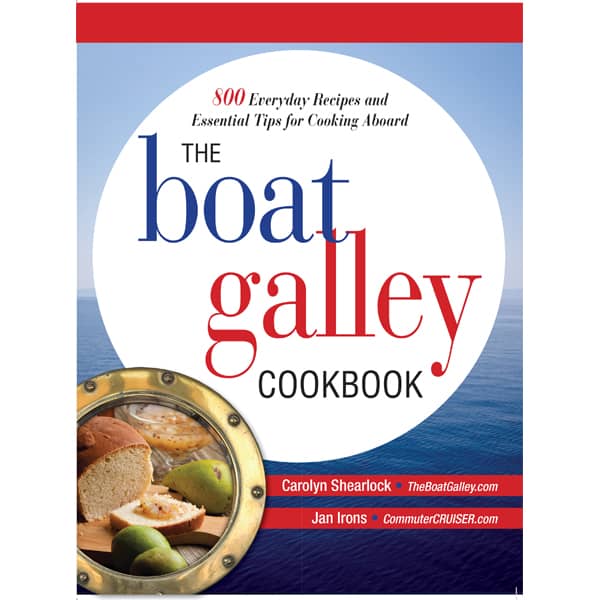
Aboard your boat, a few basic food safety precautions can go a long ways towards keeping the crew healthy. In remote locations, two potential problems exist: food may not have been handled 100% properly on its way to you, and medical help can be a distance away.
Now, I’m not a freak about food safety, such as never eating street food (in fact, I love it and have never gotten sick on it) or lettuce, but I do follow a few basic precautions. And yes, the few times I’ve ignored them, we’ve had problems. Here are my basic rules.
At the Store
- Don’t buy food that looks suspicious — this includes meat that looks like it’s been frozen, thawed and refrozen; off-color meats; packages with tears.
- Try not to buy food from bulk bins — you never know what else might have gotten in.
- Don’t buy things that look like they’ve been sitting there for a while. Anything that’s covered in dust is suspicious.
- Buy from larger stores with high turnover — food is generally fresher.
- Don’t buy anything that’s been sitting in water or ice unless you’ll cook it or disinfect it before it touches your mouth. The sickest Dave and I ever got was drinking from Coke bottles that had been “chilling” in dirty water — we were hot and thirsty and just wiped the tops off with our t-shirts instead of using a disinfectant.
- My experience has been that when the meat has looked suspect, there’s always a good selection of canned meats. Read my tips for making great meals from canned meats.
Bringing Food Home
- If the weather is warm, take coolers to the store for meats. Buy ice for the cooler, too!
- Wash drink cans and bottles before storing them (see more about storing drinks).
- Rinse produce in a dilute bleach solution as soon as you bring it aboard (read more about storing produce).
In the Galley
- Keep your hands clean. Wash them with soap and water. Experts from the CDC to various extension programs say that soap and water should be your first choice. But if you have nothing else, use a hand sanitizer.
- Keep food surfaces clean — a weak bleach solution is great for disinfecting. I keep a small spray bottle handy to use on the counter and cutting board . . . and don’t forget to spray the knife after cutting meat!
- Don’t cross-contaminate: disinfect cutting boards and other surfaces after having raw meat on them. Don’t put cooked meat back on the same plate that held raw meat without washing it — this is easy to miss when grilling.
- Avoid porous materials for anything that will come into contact with any type of food. It is simply impossible to adequately them.
- Don’t re-use plastic bags that held raw meat. If you feel that you absolutely MUST, wash them and then swish them out with a bit of bleach solution.
- Follow the “clean spoon” rule: any time you put a utensil into a container, make sure it’s a clean one. This prevents any cross-contamination. For example, don’t put the peanut butter knife into the jelly jar if you haven’t washed it in between. Squeeze bottles are great for avoiding this problem entirely!
- Cook meat thoroughly. A meat thermometer will go a long ways towards making sure that it’s cooked to a safe temperature. Since poultry and ground meat are more susceptible to contamination than other meats, be particularly careful that they are thoroughly cooked — no rare hamburgers!
Consider Pets, Too!
While dogs and cats generally don’t have huge problems with bad food or water, you don’t want them to get sick in a remote place, either. When we first adopted Paz, our vet gave us some great advice: “Don’t let her drink any water you wouldn’t drink.”
Ashore, we carried a bottle of water for Paz so that she wouldn’t be tempted to drink from puddles containing who-knows-what. We also made it a rule not to give her bits of raw meat or anything else that was suspect. And we learned to store her kibble so it didn’t get infested with bugs.
Most food safety is just common sense. The times I get into trouble aren’t because I consciously decide to take a risk, but rather because I just don’t think about a potential problem. When we began cruising, I had to re-train myself and stop assuming that food was safe.
This article isn’t designed to cover every aspect of food safety, but rather offer tips of particular importance to cruisers. For more complete food safety information, see the US government site, FoodSafety.gov.

Carolyn Shearlock has lived aboard full-time for 17 years, splitting her time between a Tayana 37 monohull and a Gemini 105 catamaran. She’s cruised over 14,000 miles, from Pacific Mexico and Central America to Florida and the Bahamas, gaining firsthand experience with the joys and challenges of life on the water.
Through The Boat Galley, Carolyn has helped thousands of people explore, prepare for, and enjoy life afloat. She shares her expertise as an instructor at Cruisers University, in leading boating publications, and through her bestselling book, The Boat Galley Cookbook. She is passionate about helping others embark on their liveaboard journey—making life on the water simpler, safer, and more enjoyable.
Simplify meal prep on board with proven strategies for provisioning, maximizing fridge space, and cooking delicious meals aboard your boat.










Wanita says
A diluted bleach spray bottle is a good idea but must be made up daily or it is ineffective. I am a Medical Laboratory Technologist, one of our duties first thing each morning was gathering up the bottles from each bench and dumping the days solution and putting in fresh.